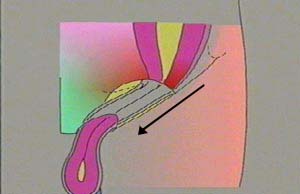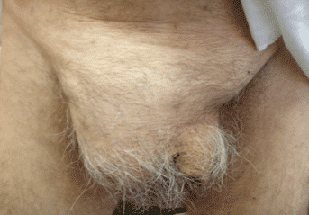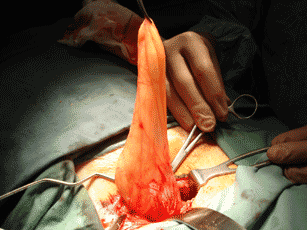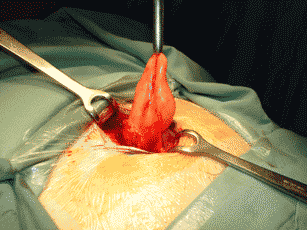Indirect and Direct Inguinal Hernia
Inguinal hernias are the most common type encountered in surgical practice (approx. 80%). They are far more common in men than women.
They occur at any age – from the newborn to the elderly. In men the descent of the testes at birth has left the abdominal wall in this region more prone to weakness and herniation. At birth there is a sac, which if it does not shrivel up, leads to the development of a hernia. With ageing, as the muscles undergo attrition, this can also cause a hernia. Straining and lifting are common factors associated with the development of a hernia. There are two basic types, but they both protrude through the superficial external ring of the inguinal canal in the groin.
The INDIRECT descends along the spermatic cord in males from the deep internal ring. Or the round ligament in females. The indirect occur at any age, from infancy to the elderly. In children or females the hernia is invariably indirect.
The DIRECT bulges through the posterior wall of the inguinal canal medial to the inferior epigastric artery, posterior to and separate from the spermatic cord. These hernias never occur in females
Direct herniae occur with increasing frequency in males as they age. The persistence of the processus vaginalis sac at birth associated with and following the descent of the testis results in the development of indirect herniae in children. This is the congenital type of the sac. With incomplete descent of the testis (undescended testis) there is usually an associated indirect hernial sac. Undescended testis is a common condition of infancy. It requires surgery to place the testis in the correct position. It may not be diagnosed early and this can cause problems. The testis in infancy, childhood and adolscence may undergo torsion ( another surgical emergency).
Persistence of a patent process vaginalis is also responsible for communicating hydroceles of the testis and encysted hydrococeles of the cord. There is conjecture as to whether this congenital type of sac (persistent patent process vaginalis) is responsible for the development of indirect herniae in adults or whether the herniae developed as a new event, associated with failure of the muscular shutter mechanism at the internal ring. The ‘congenital sac’ theory assumes there is a congenital sac which only fills with contents in adult life. It is not always possible to distinguish clinically between a direct and indirect inguinal hernia.
Some guiding points are size:
- It is uncommon for direct hernias to reach down into the scrotum, and they are generally smaller.
- It is common for direct hernias to bulge forward. They are often bilateral in the older person.
- The impulse as detected by palpation at the internal ring, is directly forward rather than obliquely.
- Pressure over the deep internal ring will prevent the descent of an indirect hernia but not a direct hernia.
While these are all practical points in differentiation there is a significant error rate in differentiation. The basic need is to be able to decide which hernia should be operated on and which can be observed and reviewed. Generally indirect herniae should be surgically repaired because they become larger, cause symptoms and may obstruct and strangulate. In children this is especially so because strangulation is more prone to occur with little warning. Direct herniae may not cause marked symptoms or become very large, nor do they obstruct or strangulate as frequently. However there can be no strict rule and direct hernias can complicate. Many other factors will decide whether surgery is carried out, but generally it is advised for either type. A truss is sometimes used to prevent the hernia protruding and to minimise the discomfort. A truss is often used when the patient declines or is considered unfit for surgery. A truss however, is not always effective and cannot be used for irreducible hernias.
Clinical Images
Below are clinical images of hernia surgical procedures. Please do not look if you are squemish.
Video of a Left Inguinal Hernia Repair under local anaesthesia with sedation
Please do not watch this video if you are squeamish. Viewer discretion is advised.
[embedyt] https://www.youtube.com/watch?v=TpO5HaPmCHc[/embedyt]







